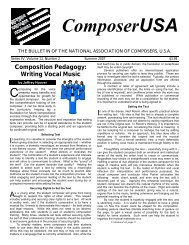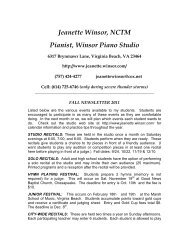1999-2007 - Music-USA.org
1999-2007 - Music-USA.org
1999-2007 - Music-USA.org
You also want an ePaper? Increase the reach of your titles
YUMPU automatically turns print PDFs into web optimized ePapers that Google loves.
I<br />
I<br />
PROGRAM NOTES -- Compiled an Edited by Max Lifchitz<br />
Mary Jeanne van Appledorn wak educated at the Eastman School of <strong>Music</strong> where her mentors included<br />
composers Bernard Rogers and Alan ~ovhankss. Her oeuvre includes works for orchestra, band, chamber and choral<br />
ensembles, solo instruments and electro-acoustic Imeans. Her compositions are published by among others, Arsis Press, Carl<br />
Fischer, Gaudia Publications and Oxford ~nivkrsit~ Press. They are available on the Capstone, CRS, Century, Crest,<br />
Northeastern, NortWSouth. Opus One and ~ienna Modern Masters record labels. Her works have been performed throughout<br />
the Europe, Japan and the US in concerts sponsoded by the Inoue Chamber Ensemble, NortWSouth Consonance, the Society<br />
of Composers, the Women Band Directors ~ajional Association and the National Association of Composers, <strong>USA</strong>. A<br />
recipient of annual ASCAP Awards since 1980, Dr. van Appledorn is the Paul Wtfield Horn Professor of <strong>Music</strong> at Texas<br />
I<br />
Tech University. She provided the following program note for her work:<br />
~ncantations, a four movement work f6r oboe and piano was commissioned by Amy Anderson for the 1998<br />
International Double Reed Society Conference. In Memoriam is an intense musical statement reflective of the emotion<br />
experienced in the loss of a loved one. This is expressed at times by quarter-tones or multipohonics sounded against prolonged<br />
I<br />
vertical structures in the piano. Bacchanal suggests a Roman Festival honoring Bacchus with its frenzied dancing, singing and<br />
revelry. The dancing oboe lines are accompanikd by ever-moving rhythms and arpeggio figures in the piano. Ambience<br />
introduces a mesmeric event for 'the listener id which the oboe has very active melodic lines rising against ambient<br />
"sostenuto" effects in the piano. Ritual expressks energetic ceremonial concepts by the oboe against the constant triplet<br />
division of the quadruple eighth-note beat in the $iano.<br />
I<br />
Based in Arlington, MA Kenneth Girard received his B.M. (1977) and M.M. with Honors (1979) degrees in<br />
composition from The New England conservatody of <strong>Music</strong> in Boston. He has produced a significant body of work including<br />
a symphony, a work for piano and orchestra, a biolin concerto, numerous works for various chamber ensembles and solo<br />
pieces, in addition to a variety of works in progre!ss (among which are several symphonic pieces, chamber works, and a string<br />
quartet). Mr. Girard's music has been performed do critical acclaim in the United States and Canada. Concerning his work, the<br />
composer writes:<br />
"My Suite for Piano, Op. 20 was begun in July of 1995 and completed in June of 1998, although the 4th<br />
movement of the work was originally begun in1 1993 as the 2nd movement of an unfinished second harpsichord sonata. It<br />
consists of seven relatively short movements with a total duration of approximately 10 minutes. The work is conceived<br />
primarily melodically/polyphonically and its landuage is that of free-pantonality.<br />
The first movement begins quietly with a shbrt section of 3-voice polyphony culminating in a loud arpeggio. The second<br />
movement is in sharp contrast to the texture and ideas of the first. It is virtuosic and begins with three string, clarion chords.<br />
Movement 3 is homophonic, commencing with1 the repetition of a single pitch that emerges into a progression of chords<br />
which expands the range outward, and conveys a quality of inevitability building to a loud climax. The fourth and central<br />
movement of the suite is a 4-voice motet. This ~dngest movement ~roiects . ., an im~elline character as voices enter in. de~art.<br />
.d<br />
1 -<br />
and return while progressing in a relatively simple rhythmic texture. Movement 5 is a single melody that traverses much of<br />
the range of the instrument. The action is fast, brief (a total of nine measures), and toccata-like conveying - - a sense of urgency - -<br />
that alternates with an occasional lyrical sweep. I~ sharp contrast, the sixth movement begins quietly. Its texture is that of a<br />
two-part invention in which the two voices are bcupied in a very lyrical and expressive dialogue. The seventh and final<br />
movement unfolds in a serene manner via a slowly ascending arpeggio that transforms into polyphonic areas of ever-<br />
' increasing intensity and impassioned declarnatiod which attain fruition in a series of robust arpeggiations."<br />
I<br />
Jeremy Beck (b. 1960) holds degrees in composition from Yale University, Duke University and the Mannes College<br />
of <strong>Music</strong>. His catalog includes a number of litekary compositions. Three such works are Black Water, a monodrama for<br />
soprano and piano (from the novel by Joyce ~&ol Oates), Death of a Little Girl with Dove, for soprano and orchestra<br />
I<br />
(inspired by the life of sculptor Camille Claudel) and Laughter in Jencho, a chamber opera based on the final confrontation at<br />
Ruby Ridge between white supremacists and ~edekal agents. Dr. Beck has received awards and fellowships from the American<br />
Composers Orchestra, American <strong>Music</strong> Center, Civic Orchestra of Chicago, Millay Colony for the Arts, Mary Duke Biddle<br />
Foundation, Wellesley Composers Conference, O!egon Bach Festival, American <strong>Music</strong> Center and the American Council of<br />
Teachers of Russian. He has published articles Ad reviews in "Notes" (<strong>Music</strong> Library Association), "Essays in American<br />
<strong>Music</strong>" (Garland Press) and "Composer <strong>USA</strong>", an!d has taught at the St. Petersburg Conservatory and Herzen University (St.<br />
Petersburg. Russia) and the Kopeyia-Bloomfield school (Ghana) His music may be heard on the ERM, CRS, heng hau, and<br />
Living Artist labels. Currently, he is teaching at Fhatham College in Pittsburgh, PA.<br />
Dr. Beck provided the following information for his piece:<br />
" Since the cello was my first instrument, my sonatas for 'cello and piano are becoming touchstones for my work and<br />
reflect my evolution as a composer. I've given 4 subtitle to this sonata: "Moon." As well, each of the three movements




